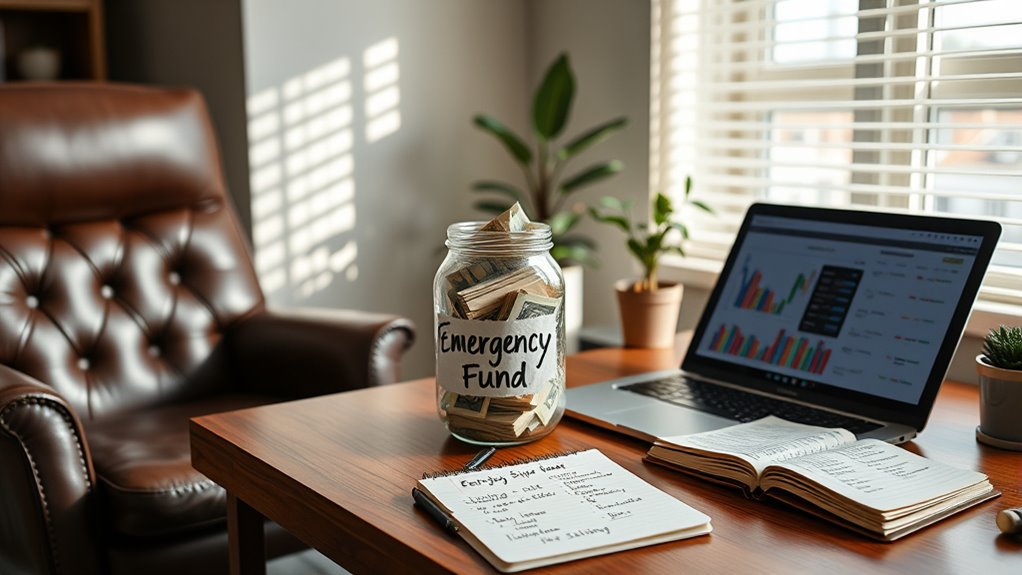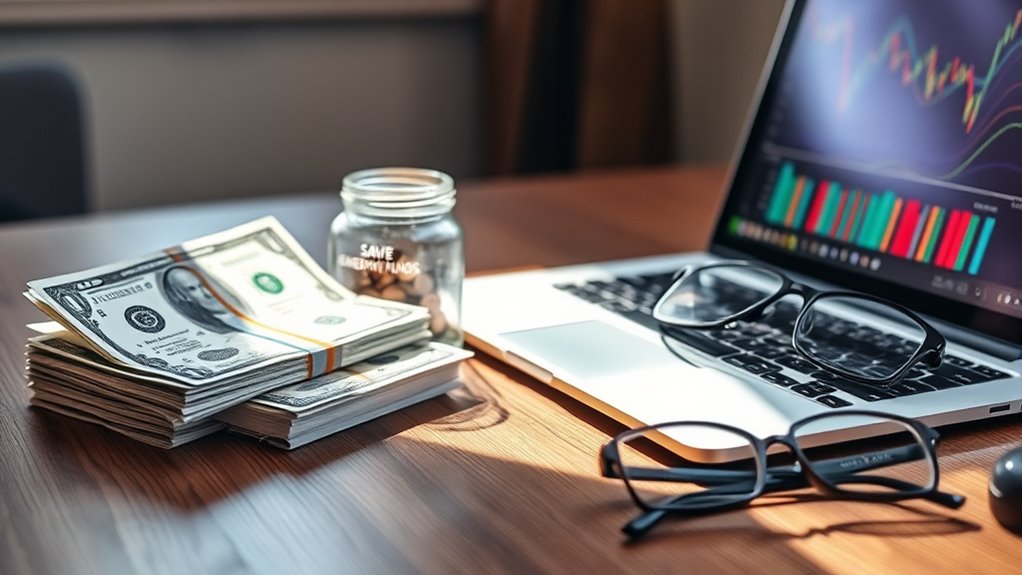To prioritize your money goals effectively, focus first on building an emergency fund that covers three to six months of living expenses. Once that’s in place, shift your attention to paying off high-interest debt and start investing for long-term growth. Balancing both short-term security and future wealth is key to financial stability. Keep exploring strategies to optimize your money management for better results.
Key Takeaways
- Build an emergency fund covering 3-6 months of expenses before focusing heavily on investments.
- Prioritize paying off high-interest debt to improve financial stability and free up funds for future goals.
- Once debt is reduced and emergency savings are sufficient, shift focus to investing for long-term wealth.
- Balance saving for emergencies with investing to ensure short-term security and long-term growth.
- Use a strategic approach that addresses debt, emergency funds, and investments based on your financial situation.

Have you ever wondered whether you should prioritize building an emergency fund or investing your money? It’s a common dilemma, and the answer depends on your current financial situation and your future goals. Starting with an emergency fund is generally the first step because it provides a safety net for unexpected expenses like medical bills, car repairs, or sudden income loss. Without this safety net, you might be forced to dip into your investments or go into debt when surprises arise. An emergency fund helps you avoid high-interest debt and keeps your financial stability intact, especially if you’re working towards long-term goals like retirement planning.
Prioritize building an emergency fund first to safeguard against unexpected expenses and maintain financial stability.
Once you have enough in your emergency fund—typically covering three to six months of living expenses—you can shift your focus toward investing. At this point, you might consider putting money into retirement accounts, stocks, or other investment vehicles to grow your wealth over time. However, it’s worth noting that investing isn’t just about wealth accumulation; it can also support debt reduction strategies. For example, if you have high-interest debt, such as credit cards or personal loans, it’s often wiser to prioritize paying that off first. The interest on debt can outweigh the gains you’d make from investments, so reducing debt can be a smarter move for your financial health.
Balancing these priorities requires a strategic approach. If you’re carrying significant debt, especially high-interest debt, tackling that should come before heavy investing. Clearing debt not only improves your cash flow but also reduces the financial burden that might prevent you from saving or investing effectively in the future. Conversely, if your debt is manageable and you’ve got a solid emergency fund, investing can accelerate your journey toward financial independence and retirement planning. Building a diversified portfolio early on can yield compounding returns that profoundly benefit your long-term goals. Additionally, staying informed about emerging AI security challenges can help you make smarter financial decisions in a rapidly evolving technological landscape.
In essence, your priorities should be guided by your immediate needs and future aspirations. An emergency fund is vital for short-term security, but investing is essential for long-term wealth building. By establishing a strong safety net first, you’re better positioned to take calculated risks and avoid setbacks caused by unforeseen expenses. Remember, a balanced approach—focusing on debt reduction, emergency savings, and then investing—sets a solid foundation for your financial future. This way, you protect yourself against surprises today while steadily working toward your retirement and other goals tomorrow.
Frequently Asked Questions
How Much Should I Ideally Have in My Emergency Fund?
You should aim to have at least three to six months’ worth of living expenses in your emergency fund, based on savings benchmarks. This cushion helps cover essentials like rent, food, and bills if unexpected events occur. Follow emergency fund tips by keeping this money in an accessible, low-risk account. Adjust the amount depending on job stability and personal circumstances to make sure you’re protected without over-committing.
When Should I Start Investing After Building an Emergency Fund?
You should start investing once you’ve built a sufficient emergency fund and managed your debt effectively. Prioritize your emergency fund to cover 3-6 months of expenses, then consider retirement planning and other financial goals. Starting to invest after these steps guarantees you’re protected against unexpected costs and debt. This balanced approach helps you grow wealth steadily while maintaining financial security.
Can I Balance Saving for Emergencies and Investing Simultaneously?
Yes, you can balance saving for emergencies and investing simultaneously. Good financial planning involves setting clear priorities and allocating your income accordingly. Start by building a sufficient emergency fund, then gradually allocate funds for investing to grow your wealth. Effective wealth management means reviewing your goals regularly and adjusting your savings and investments. This way, you guarantee you’re prepared for unexpected expenses while working toward long-term financial success.
What Are the Risks of Prioritizing Investing Over Emergency Savings?
Prioritizing investing over emergency savings exposes you to higher risk exposure, especially if unexpected expenses arise. You might face significant opportunity costs if you need quick cash and haven’t built a sufficient emergency fund. Without enough liquidity, you could be compelled to sell investments at a loss or incur debt, making your financial situation more fragile. Balancing both goals helps minimize risk and ensures you’re prepared for surprises.
How Do I Adjust My Priorities During Unexpected Financial Crises?
During unexpected financial crises, you should prioritize building your emergency fund to guarantee financial flexibility and effective crisis management. Cut back on non-essential expenses and redirect funds toward your emergency savings first. Once you regain stability, then you can shift focus back to investing. Maintaining this balance helps you navigate emergencies smoothly while still working toward your long-term financial goals.
Conclusion
Remember, building your emergency fund is like laying a sturdy foundation before you start decorating your financial house. It keeps you safe when surprises strike, while investing helps your money grow over time. Prioritize your emergency fund first, then shift your focus to investing once you’re protected. Think of it as planting seeds now so you can enjoy a flourishing financial garden later. Balance is key—strike it right, and your goals will flourish.









